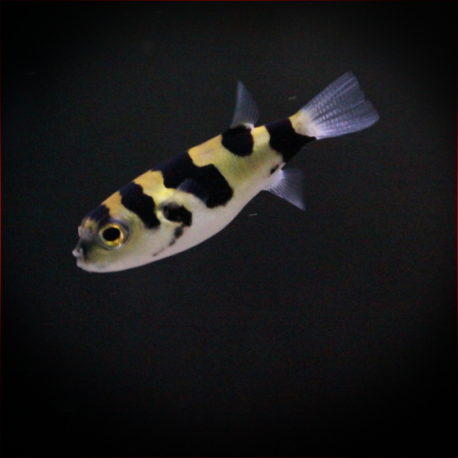More info
Datasheet
| Minimum Tank Size | 115 litres / 30.38 US gallons |
| Maximum Size | 12.8cm / 5.04inches |
| Temperature | 20°C / 68.00°F - 26°C / 78.80°F |
| Hardness | 2.02dgH / 36ppm - 15.02dgH / 268ppm |
| pH | 5.5-8.0 |
General Description
The Amazon Puffer, scientifically known as Colomesus Asellus, is commonly referred to as the 'South American puffer,' 'SAP,' 'Amazonian puffer,' 'Peruvian puffer,' or 'Brazilian puffer' in the ornamental trade. This freshwater species is a member of the Tetraodontidae family within the Tetraodontiformes order. It is distinctive for its unique morphological adaptations, such as the ability to inflate its body when stressed by drawing water into a specialized ventral diverticulum of the stomach. These puffers swim using a unique combination of pectoral and median fin undulations known as 'diodontiform' swimming.
Aquarium Setup
The Amazon Puffer requires a tank size of at least 115 litres. It is essential to maintain a well-decorated set-up with the addition of floating or overhanging vegetation, driftwood roots or branches, and a clean environment free from organic waste. These puffers are sensitive to water quality, necessitating moderate levels of dissolved oxygen and water movement. Regular water changes of 30-50% are recommended, along with the use of powerheads, pumps, and possibly a linear flow pump. Wild-caught Amazon Puffers may need a prolonged quarantine period due to their delicate nature.
Behaviour
The Amazon Puffer is not inherently aggressive, but it is unsuitable for a general community aquarium. It is best kept alone or with other fluvial fishes in a larger set-up. These puffers tend to form loose aggregations and may display nervous behavior in the absence of conspecifics. It is advisable to purchase a group of six or more to ensure their well-being.
Feeding and Diet
Amazon Puffers lack true teeth and have jawbones modified into four fused tooth-like structures that grow continuously. Their diet should consist of shelled invertebrates like snails, crab legs, and cockles. Aufwuchs can also be a significant part of their natural diet, and encouraging algal growth on decor items could be beneficial. Other suitable foods include chopped shellfish, small earthworms, live or frozen chironomid larvae, Artemia, and similar items. Dried foods should not be the primary diet, although pelleted formats with a hard consistency can be offered.
Reproduction & Dimorphism
Reproduction of the Amazon Puffer has not been recorded in aquaria. They exhibit a spawning strategy similar to marine puffers, with high fecundity, small eggs, and no parental care. Limited studies suggest that spawning occurs in main river channels or near the mouths of floodplain lakes during periods of high water. Pelagic larvae are carried into nursery zones in floodplain lakes for development before returning to river channels.
Habitat and Distribution
The Amazon Puffer is found throughout much of the Amazon basin in Brazil, Colombia, Peru, and Ecuador. It inhabits various rivers including the Amazonas/Solimões main channel, rios Pará, Tocantins, Jari, Xingu, and others. These puffers are commonly seen in habitats with high oxygen levels, such as sandbars, floodplain lakes, and fast-flowing rapids over bedrock. Their range extends to the Essequibo and Waini drainages in Guyana and the lower Orinoco in Venezuela, but they are absent from French Guiana and Suriname. The species is not typically found in highly acidic black-waters.
The above text provides detailed information about the Amazon Puffer, covering its behavior, feeding habits, habitat requirements, and more. It is essential to consider these aspects when caring for this unique freshwater species.

